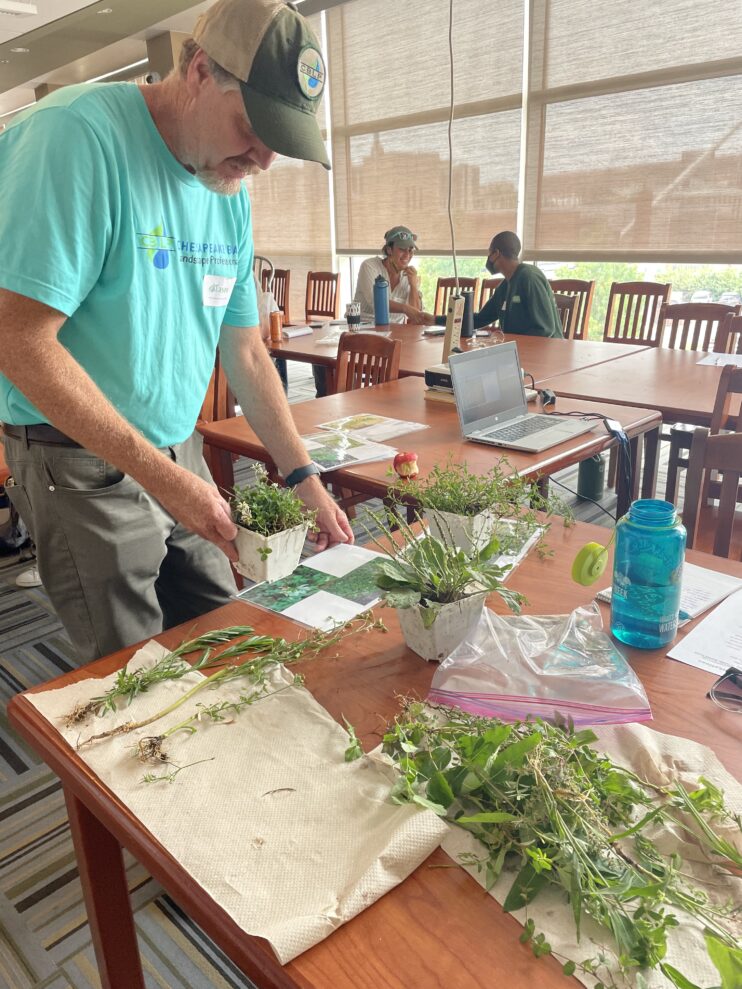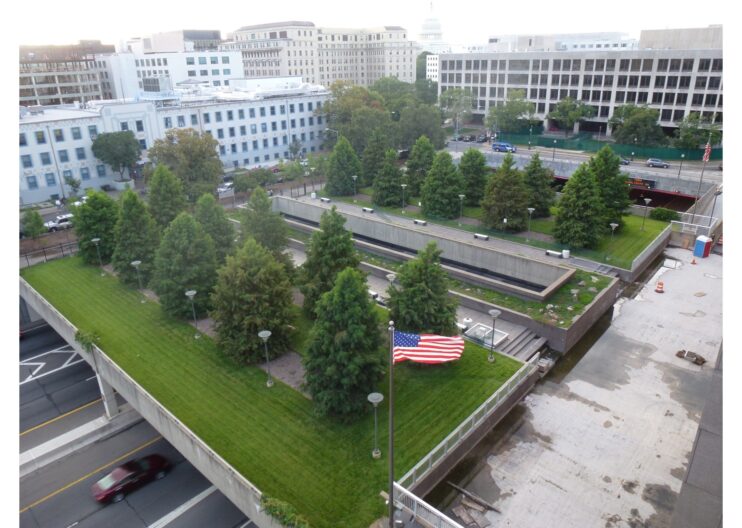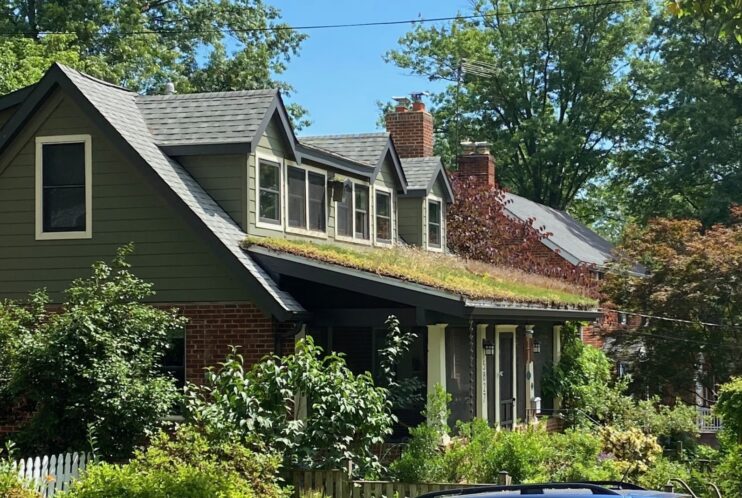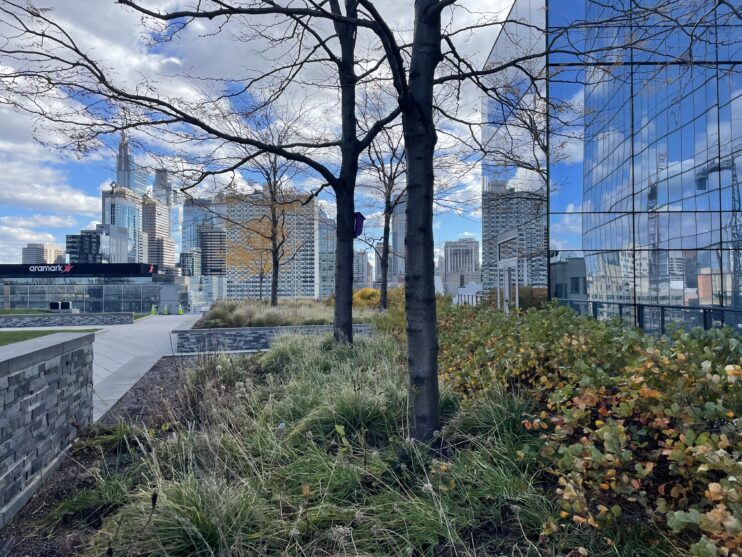Blogger Beth Ginter
July 2, 2025
Green Roofs: Reaching for the Sky and a Cleaner Bay
You may have looked up from a city sidewalk to see leaves and branches peeking over the edge of a tall building or been surprised to see a meadow sparkling with flowers outside an office window. Your eyes weren’t deceiving you. Along with streetside green stormwater infrastructure practices like bioretention and permeable pavement, green roofs are helping restore the Chesapeake Bay. Among their many benefits, green roofs reduce runoff and the resulting negative impacts of pollutants in local waterways, and provide key spaces for habitat.
Did you know that you don’t have to specialize in green roofs to maintain them? Armed with an understanding of the unique conditions found on rooftops, appropriate safety equipment, and the proper insurance, landscape professionals can also perform green roof maintenance. On Friday, July 18, 2025, we’re offering a one-day workshop on caring for green roofs at the University of Maryland in College Park. The session seeks to demystify green roofs and is ideal for landscape contractors, maintenance teams, facility managers, and others who care for green roofs and want to keep up with best practices. No prior experience is required to attend. CEUs are available. Learn more about the session and register here.
CBLP DC-MD-WV Coordinator, Jason Swope, points out the benefits attending the training don’t stop when the class ends. “Like all CBLP courses, this workshop offers the opportunity to get to know other experienced green roof professionals as well as others who are just starting out. When you have a question about a green roof down the road, you will have access to a network of people with answers.”

CBLP DC-MD-WV Coordinator, Jason Swope, organizing Sedum plants for a learning activity at 2022 Green Roof Maintenance Workshop in Washington, DC.
What’s a Green Roof?
“It’s not paint,” Rebecca Stack laughs. She is a civil engineer, educator, and principal of Designgreen in Washington, DC, and an instructor in the Chesapeake Bay Landscape Professional (CBLP) certification program and the upcoming workshop. She explains that a green roof is an engineered system of plants living in a special lightweight growing medium, usually with a tray or matting under it all to protect the roof, support the plants in absorbing water, and send excess water to the roof drains.
Most of her work with Designgreen takes place in dense urban areas. “As an engineer who is trying to create sustainable, resilient, healthy environments, oftentimes the rooftop is the best place to work. On the ground there can be a lot of demands for the space. The roof is real estate that is often available that people don’t use.”
She continues, “It’s a great place to create more nature than you normally would have in a city.”
Like other green stormwater infrastructure practices in our tool box, green roofs can be a way for property owners to meet stormwater management regulations, restore habitat, reach LEED certification levels, take part in the Living Building Challenge, or serve their individual sustainability or mission-focused goals.
Types of Green Roofs
Green roofs can be as elaborate as your client’s budget, building, and creativity allow.
For a look at some typical green roof plants, Rebecca points property owners to the online catalog for Emory Knoll Farms, a wholesale nursery in Street, Maryland..
Rebecca explains that the most common types of green roofs are those with low growing vegetation – often sedum – that covers a large portion of a roof while avoiding HVAC and other rooftop equipment. Options for constructing these “extensive” roofs, with shallow soils, include rolling out pre-grown mats or installing tray systems with pre-grown vegetation, or even placing special sacks of plants on the roof that are designed to disintegrate as the plants grow. “There’s tons of innovation around green roof products,” Rebecca notes.
More complex, or “intensive”, green roofs are usually found on newer, larger buildings that are engineered to support their weight. Deeper soil media can support deeper-rooted shrubs, small trees, and planters. If there is safe access to the roof and the roof will support it, some roofs offer paths to patios or other living spaces.
“We often think of green roofs as a technology for buildings, but they can be on many types of structures,” Rebecca explains. She points out that in Washington, DC, for example, a pedestrian courtyard built over the I-395 highway features bald cypress trees.

Green roofs can find a home on a variety of structures. Here a green roof spans I-395 in Washington, DC.
Photo credit: Darren DeStefano, Horticulturist, GSA
Landscape architect and certified CBLP, David Chewey, is another proponent of green stormwater infrastructure who has experience with green roofs. He has a contract to design and install a green roof on a three-story mixed use building in Norfolk, VA, that will feature an exercise gym and outdoor living space for the owner, with a patio structure, planters, and a walkable surface. For a large project in New Jersey, he designed a rooftop amenity for condominium residents that also managed the building’s stormwater.
David notes that not all green roofs need to cover thousands of square feet. “You need out-of-the-box thinking about where to put a green roof. It could easily be a covered garbage bin – a little thing like that – or a shed or free-standing garage, if a structural engineer verifies it can withstand the extra weight,” he says. “It’s a wonderful way to add a little green to your life.”

Extensive green roof retrofit on a residential porch in Arlington, VA, requires minimal soil
The Many Benefits of a Green Roof
Green roofs offer wildlife, people, and the environment many advantages. Rebecca Stack explains, “It is not just managing the rainwater to help streams stay healthier. If you have a lot of them, you create a green flyover zone for birds, bees, and insects, you lower the heat island effect, improve air quality, and, depending on the building, green roofs have the ability to lower the cost of energy to heat and cool the facility. It’s a little magic bullet,” she says.
The rewards of having a green roof include:
- Stormwater Management: Green roofs slow down stormwater and reduce runoff. It’s especially helpful to capture that first flush of rain before it washes pollutants that have settled on roofs into the drains and eventually local streams, rivers, and the Bay.
- Reduced Heating and Cooling Costs: Green roofs offer a layer of insulation that protects a building and its occupants from temperature extremes. That can mean less demand for air conditioning in the summer or heat in the winter. It also helps moderate the “urban heat island” effect that raises temperatures in cities.
- A Haven for Pollinators: Many green roofs, especially those that incorporate native plant species, provide habitat for insects and other pollinators, many of which are stressed and in decline.\
- Supporting clean air: As plants grow, they help reduce dangerous levels of carbon dioxide and exchange it for the oxygen we need.
- Sustenance for Migrating Birds: When millions of migrating birds move through the Chesapeake region along the Atlantic Flyway each spring and fall, seeds from plants on green roofs offer fuel for the journey.
- Stress-Busting Views: Looking out over a rooftop bursting with greenery, birds, and pollinators offers you a trip to nature without leaving your couch or office chair. Even brief time in nature can support your mental health.
Del Ray Landscapes owner and Level 2 certified CBLP, Brian Schmauder, has taken our green roof training and has experience maintaining green roofs and other green stormwater infrastructure practices. He encourages more people to think about the benefits of the ecotechnology.
His company is based in Alexandra, Virginia, not far from the Potomac and Anacostia rivers. He points out that green roofs, coupled with other conservation landscaping practices, can help slow down stormwater before it reaches the river. Treatment trains are helpful in big storms, he explains. DC has a combined sewer and stormwater system. When it’s overloaded, waste can end up in our river’s ecosystem. It’s a concern for the river and Chesapeake Bay, and nearby residents.
Despite the expense of installation, Brian encourages those who have flat roofs to think of the space as a third or fourth room in their house. “Installing a fire feature, pergola, or raised planters full of beautiful plants – that is the future of green roofs.”
Brian looks forward to green roofs becoming more commonplace. “I love the idea that you could look out and see a green city in front of you. I think that would be the coolest thing: to be in any big city like DC and look out and see that everyone’s roofs are green. There’s no real reason why we need to rely only on rubberized or tarred roofs.”

Some intensive green roofs have deep soil media to support a diverse palette of native trees, shrubs, and herbaceous plants.
Roles for Landscape Pros
You may have a client ask about adding a green roof, or perhaps you want to recommend one. When planning a green roof, first, think about your client’s goals. Why do they want a green roof? Is it for the views? Stormwater management? Habitat enhancement? When you know what you want the roof to achieve, consult with experienced green roof professionals.
Because green roofs add weight and require specialized equipment, materials, and plants, make sure you know your own professional limitations and seek out collaborations with experts who can provide the engineering, design, and construction services needed to ensure a successful project.
Most specialized green roof firms provide comprehensive green roof services and while many such contractors include a short-term maintenance contract in their project budgets, performing that maintenance, especially on smaller residential and commercial roofs, isn’t always profitable for these businesses. But like other green stormwater infrastructure, green roofs need ongoing maintenance beyond the establishment period. This presents an opportunity for landscape professionals to manage care of green roofs in the longer term. Additional opportunities exist for landscape designers to develop green roof planting plans or serve as a liaison with clients, working hand in hand with the architect and contractor for each project, and learning a lot as you go.
Many thanks to Emily Littleton for conducting interviews and for editorial support.
 Beth Ginter is the first Executive Director of the Chesapeake Conservation Landscaping Council. Additionally, she oversees the Chesapeake Bay Landscape Professional (CBLP) program, a certification effort which provides consistent training and practice standards for landscape professionals working in the Chesapeake Bay region, Ms. Ginter has a Masters degree in Sustainable Landscape Design from The George Washington University. Her limited free time is spent with her family, walking her corgi, and catching up on her reading.
Beth Ginter is the first Executive Director of the Chesapeake Conservation Landscaping Council. Additionally, she oversees the Chesapeake Bay Landscape Professional (CBLP) program, a certification effort which provides consistent training and practice standards for landscape professionals working in the Chesapeake Bay region, Ms. Ginter has a Masters degree in Sustainable Landscape Design from The George Washington University. Her limited free time is spent with her family, walking her corgi, and catching up on her reading.


